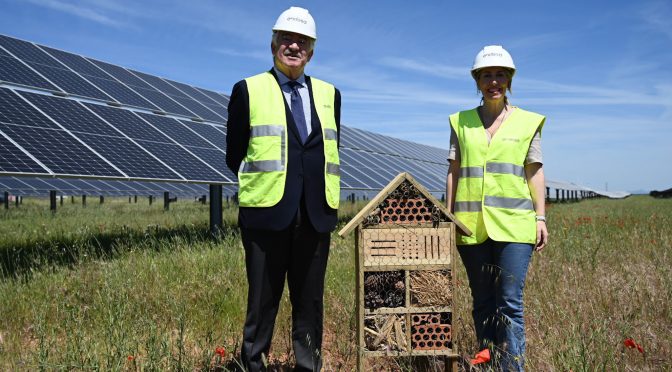The Puerta Palmas solar plant has become a biodiversity refuge thanks to the creation of a reserve of more than ten hectares dedicated to the conservation of the little bustard, a steppe bird in danger of extinction. Endesa’s solar plants in Extremadura are an example of coexistence between technology and the environment thanks to the close collaboration between Endesa and the Government of Extremadura, which has allowed the development of innovative projects that have recognition at the European level.
The president of the Regional Government of Extremadura, María Guardiola, and the CEO of Endesa, José Bogas, visited today the first steppe bird reserve in a solar plant. This is a conservation project for the little bustard, a steppe bird that is among the endangered species, which is being carried out on more than ten hectares at Endesa’s Puerta Palmas solar plant in the province of Badajoz. .
During his speech, José Bogas highlighted that “today we are going to see an example of public-private collaboration, developed by the interest of the regional government with those of the community together with the interest that electric companies have with the development of renewables and the sustainable development, both social and environmental. We have developed many more examples in Extremadura in the 21 parks we have, which total 2,277 MW of power in Extremadura, and which have to do with biodiversity, with birds, with livestock, with flora, which demonstrate how it can be integrated an industrial facility in the countryside and how to make that clean energy compatible with economic and social development.”
For her part, the president of the Extremadura Regional Government, María Guardiola, has stated that “we wanted to come and visit this plant because it is the perfect example of the coexistence between development and the protection of the natural environment. We have always defended the importance for us of finding the balance between development and economic growth and the protection of the Environment. In this sense, I want to highlight that the energy sector in Extremadura is leading. “Practically 100% of the energy we produce here is clean energy, it does not generate CO2, and we export more than 80% to other regions.”
Puerta Palmas, biodiversity refuge
The Puerta Palmas solar plant has become a safe refuge for the little bustard thanks to the space reserved for this steppe bird where it finds food without pesticides, the presence of hunters or harvesters and a refuge from the heat under the solar panels. In fact, the study that is being carried out between the Department of Agriculture, Livestock and Sustainable Development of the Government of Extremadura and the renewable subsidiary of Endesa, Enel Green Power Spain, reveals that in the last year the bustard population has integrated into the 120 hectares of the solar plant, leaving the reserve area and finding a safe refuge in the facility.
According to the first data from the study that is being carried out jointly, of the pair of two male Little Bustards found in the spring of 2023, their population has already tripled in the month of March. In addition, it has been identified that the little bustards have left the designated area and walk around the solar plant using the shade of the panels as shelter.
From left to right: José Bogas, CEO of Endesa, and María Guardiola, president of the Regional Government of Extremadura, filling the first drinker for the little bustard.
The president of Extremadura and the CEO of Endesa have had the opportunity to learn up close how the operation and maintenance of the solar plant itself has been adapted to the needs of this species.
In this sense, it has been highlighted that, to promote and contribute to the conservation of the little bustard, specific actions are carried out such as the control of grazing with sheep, limited to the period that does not harm breeding, or the adaptation of firebreaks to help the species range. In addition, biological stops are carried out during the clearing and cleaning tasks during the breeding period with supervision of nesting to eliminate its impact. Likewise, to encourage this coexistence, Endesa has installed drinking fountains both in the bustard protection area and in the solar plant itself, to facilitate hydration in the hottest season.
Today, precisely, María Guardiola and José Bogas have been in charge of filling the first drinker prepared for the little bustard and other birds that have their natural habitat in the solar plant. In fact, in the installation you can see nesting houses for different species of birds and, among other environmental measures, one of the insect hotels has been shown that will be placed between solar panels to favor the habitat of the species that reside in the plant. Puerta Palmas plot.
The president of the Government of Extremadura and the CEO of Endesa have also been able to learn about the rosemary planting work that Endesa’s renewable subsidiary, Enel Green Power España, is carrying out in another solar plant, Zurbarán (in the province of Cáceres) within the framework of the European project SUSTAINEXT. These cultivation works are aimed at aromatic plants for the extraction of high value-added products such as vegetable oils at an industrial level that, in turn, will be introduced into the land of the solar plant.


